This will be the penultimate post recounting the first stage of my ongoing experience with cancer. The stage that I’ve come to think of as Coping with Cancer. To tie this experience off, I’m going to include my stoma reversal surgery in this stage.
In actual fact, my stoma reversal surgery didn’t happen until spring 2017, around two years after the events that I’ll cover, next week, in the final post in this ‘Coping with Cancer’ stage.
The reason for this decision is that I want anyone reading the ‘Coping with Cancer’ aspect of my life to see a complete process: from being told you have cancer, to being given the all clear. And what can happen after you receive that news.
But that wasn’t my experience.
Because my bowel ruptured, it took longer than usual to get to the stoma reversal surgery. By the time the surgery was booked, my scans showed my first recurrence, and the surgery was postponed. And I had moved into, what I call, the Living With Cancer stage, where I currently reside. And which will be the focus of the ongoing posts in a couple of weeks time.
But, for now, I’m going to talk about my stoma reversal surgery, as it happened to me… just a couple of years out of time!
Warning: includes graphic post-surgical photos
By the time the surgery was booked, I’d had my colostomy bag for plenty long enough. I was ready to get back to the way things were supposed to be. Keen, in fact. That said, I didn’t have to have the reversal at all; I could have opted to keep the colostomy bag for life. Apparently some people do choose this, but I wasn’t to be one of them.
I knew that the stoma reversal surgery would have to be an open surgery, not keyhole, due to the complications of the original bowel surgery. I knew this meant that I’d be left with a large scar, a long recovery time and a fair amount of pain. But I also knew it was going to be worth it.
Finally, the day of the surgery came. And went!
Unfortunately the guy who went before me had some complications on the table. He survived but it took so long to deal with, that I’d have to come back the following day. This did nothing to ease my mind about the coming surgery and I didn’t get much sleep that night.
And then the day of my stoma reversal surgery actually did arrive. The surgery is actually called the ‘Hartmann’s Reversal’. In addition to this, there was some light repair to my parastomal hernia. Which is where a loop of intestine had managed to sneak out the gap in my abdominal wall, which was made for the stoma, and nestle under the, well, fat of my belly.
Off I went. Things happened – mainly me being gutted like a fish – and then I arrived back in my room with a lot of tubes sticking out of me. But not an ileostomy bag. Which was nice because I didn’t want to end up living with an ileostomy bag, instead of colostomy bag; it didn’t seem like a huge step forward. As it turns out, with the advancements in technique, the use of ileostomies in these circumstances is pretty rare, these days. Works for me!
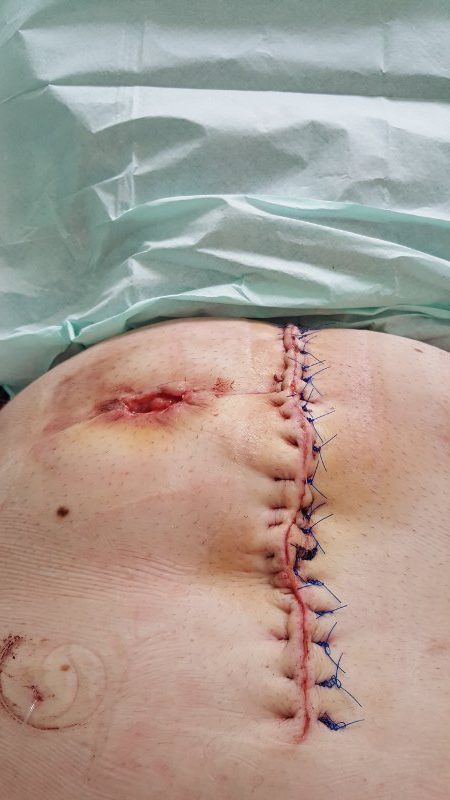
Among the accessories I did have were tubes that delivered local anaesthetic directly to each side of the surgical wound. And these were extremely useful because, as usual, I was expected to get out of bed the same day as the surgery. This time, however, I was extremely motivated, because I wanted my bowels to start working very quickly. I could then avoid having a tube threaded through my nose, and down my throat, as I had after the surgery to remove the bowel cancer. Because, as strange as it might sound, that tube down the throat was the worst thing I’d experienced during any of these surgeries.
And, given that I now had a 10 inch long scar running right down my center line, which made getting in and out of bed a somewhat agonising ordeal, that tells you how much I hate that tube.
So, get out of bed, I did. Even if it was just to sit in a chair next to the bed, for that first day. The following day, there was some light staggering around the room. Once the urinary catheter came out, I was willing and able to start prowling the corridors. And, on the third day, I went home. My nose and throat inviolate…
One of the strangest aspects of my recovery was how swollen my abdomen was. Looking down, everything was taut, and I spent quite a while thinking I was going to get away without having a belly-butt. I was horribly wrong, I was just so swollen that I couldn’t gain perspective on how rotund I was. When the swelling finally went down, the belly-butt was back to stay.
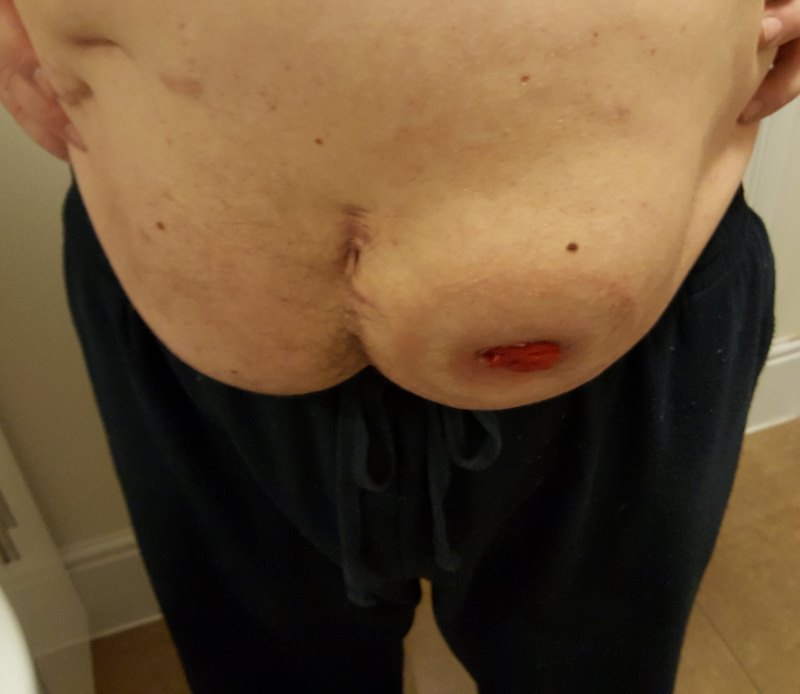
A belly-butt is an unfortunate consequence of having a center line scar and a flabby belly. The scar heals and doesn’t stretch. The belly then ends up sagging either side of the immovable scar. And the end result is that you end up looking like you’re got a set of buttocks for a belly: a belly-butt.
The solution is obvious: lose weight!
Sadly, obvious isn’t the same as easy…
It’s the sort of thing that can really knock your confidence, especially if you’re wanting to wear a swimming costume. Summer holidays become awkward, Swimming to lose weight becomes awkward. The only workable solution I’ve found to date, is to wear a rash vest. But a rash vest in a public, heated swimming pool also draws more attention than you’re likely to want.
While my solution remains that I need to lose a lot of weight. The best solution, for anyone else facing this sort of thing, is to not have the weight in the first place. Prevention is better than cure. As ever, keep yourself as fit and healthy as possible and avoid situations like mine.
But, anyway; back to bed.
At home, in your own bed, you’re likely to be faced with a number of challenges:
- Getting into bed
- Finding a comfortable sleeping position
- The lack of really good pain medication
- The ongoing need to go to the toilet
- Getting out of bed.
There are also the other little things like: your first cough; your first sneeze, etc. Nothing says ‘welcome back’ quite like your first sneeze after surgery. But we’re talking about problems specific to this stoma reversal surgery.
Most of the problems stem from the need to go to the toilet, because you’ll have gotten out of the habit of doing it the old fashioned way. And you won’t trust your body or the signals you’re getting from your rectum. I certainly didn’t.
The biggest single issue was breaking wind… flatulence… farting!
For a surprisingly long time, you won’t be able to tell if you need to go for a poo or you just need to fart. And you’re unlikely to want to take the risk, given that you’re lying in your nice, clean bed. This means an awful lot of trips to the toilet, at all times of the day and night. Which means you’re going to be tired.
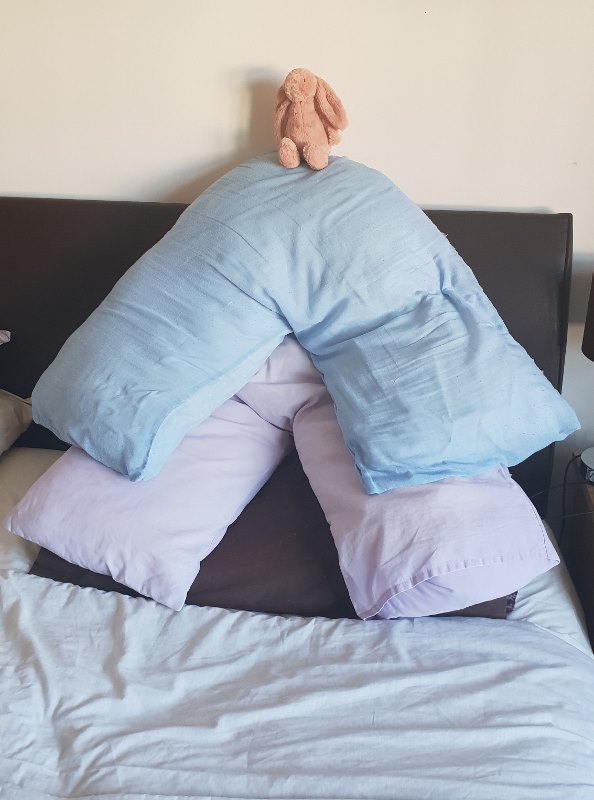
Not that you weren’t tired, anyway. Because, unlike hospital beds, most beds at home don’t allow you to adjust your position from a 45 degree incline to perfectly flat, at a touch of a button. And you need to be at a 45 degree incline, if you’re going to stand a chance of getting any sleep. But you need to be perfectly flat to maneuver yourself in and out of bed to get to the toilet. Which means the judicious use of pillows.
And pillows are fine, especially V shaped pillows, which can help prop you up in just the right way. But getting them out from behind you, when you want to get up, involves a lot of stretching and tugging, and is remarkably difficult to do with a 10 inch wound running down your belly.
All this movement would be much easier if you were allowed to bring any of the good pain medications home with you. But you’re not. Which means that the movements to get in and out of the bed have to be small and gentle. The lack of decent meds also means that your constipation has come to an end, which means you really need to go to the toilet. A lot.
I made a note, in my diary, about the right way to get out of bed:
The only way to get out of bed, in those first couple of days, is slowly and carefully. The bed needs to be reasonably flat and you need to shuffle round so you’re lying on your side, facing the edge you want to get up. The shuffling process will hurt, but you need to suck it up. You then, in one smooth motion, pivot around your butt into a sitting position with your legs dangling or, better still, your feet on the floor. The first couple of times you do this you will need help.
I can’t emphasis enough how important it is to make sure you remember that you’re hooked up to a catheter at this point.
The last sentence doesn’t really apply when you’re at home. But you’ll start doing this while you’re in hospital and I thought it was worth the mention.
Talking about things ‘I can’t emphasis enough’: baked beans.
Don’t eat them in the first month after your stoma reversal surgery. Seriously, just don’t! Again, there is a passage from my diary that seems pertinent at this point:
There simply can’t be anyone for whom the taste of baked beans is worth the resulting fartfest and uncertainty. If you don’t know what the word Shart means, eat baked beans and all will become clear. Also, avoid any carbonated beverages and fizzy drinks, as it turns out that the bubbles in the drink don’t magically disappear once they hit your stomach…
There is, however, a solution to all this uncertainty. It’s just not very glamorous. Adult nappies!
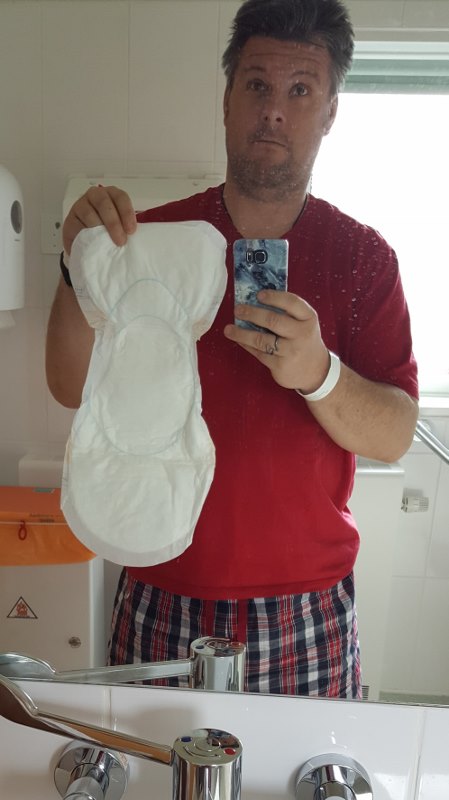
I wore them for over a week. Thankfully, I never actually had an accident, but wearing them gave me the confidence to get on with my exercise and recovery. I would suggest that, if you’re going to go down this route, spend the extra money to get the least plasticy ones you can. The ones from the hospital were great. All cottony and soft. The ones I got from the supermarket were terrible; all plasticy and sweaty. Icky, I think is the word. Trust me and spend the money; I wish I had.
And then, after a couple of weeks, it’s time for the stitches to come out. I had quite a few stitches. It took the nurse quite a while to get them out. It was a pretty sore process. But the net result, I’m sure you’ll agree, was worth it; virtually no mark at all.
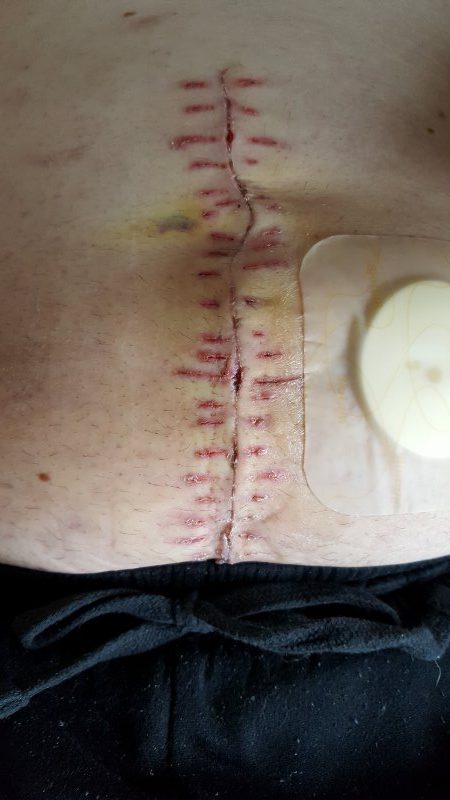
While the scar from the surgical incision was very impressive in size, it was the one from the stoma that most fascinated me. It was astonishingly deep. At one stage, it could easily have taken my index finger up to the second joint. Yet it wasn’t stitched up, it was just left to its own devices. And it worked. It closed up and healed with just a dressing to keep it clean. Of course, it’s left a really ugly scar and, given the state of my belly, that’s actually saying something.
In all, it took about a month to feel in control of my bowel movements again. And another month for my wounds to properly heal.
But the reward was not having to carry a backpack, with all my colostomy bag changing gear, everywhere I went. I was able to go places and do things without worrying that my stoma would fart at the most inopportune moment.
Physically I was free.
Physiologically, I was complete.
Neither of these things, of course, was completely true but I certainly felt better.
That said, and in a strange way, I quite often miss my colostomy bag. There was a certain convenience to changing your bag. Most of the time is was really quick and easy and at the time of your choice. It’s odd; I spent so long, desperate to get rid of that damn colostomy bag. And now it’s gone…
But the mind is a funny old thing. Which is the topic for the next post.
However, in terms of the physical aspects of the ‘Coping with Cancer’ stage of treatment, my stoma reversal surgery marked the end. And for most people, this process would be done by keyhole surgery, so the recovery time and pain involved would be much less. Even for me, it was well worth it and the scars are kinda impressive.

6 thoughts on “Stoma Reversal Surgery After Bowel Cancer”
Thank you for sharing this I am having colostomy reversal surgery in 19 days. Back in October of 2019 I had a colon resection done but ended up with an anastomoses leak which of course caused sepsis and I ended up on life support for almost 2 weeks. I was just wondering when you midline incision was out back together was it done by a plastic surgeon or just your colorectal surgeon? Thank you again for sharing your journey!
Lauren
Hi Lauren,
Sorry to hear about your difficulties with the resection, I’ve got my fingers crossed that the reversal goes a lot smoother.
I’m pretty sure that my colorectal surgeon did all of it. I certainly never heard that there was a plastic surgeon involved. I don’t imagine it could hurt to ask for a plastic surgeon to put you back together, I don’t imagine they’re that busy at the moment and might appreciate the opportunity to keep their eye in.
Either way, I hope you have a nice, paper-thin scar when everything settles down.
All the best,
Paul
I have see blood in my poo 2 different occasion, can you tell me more symptoms you saw so I can compare to mine if I’ve got any of these symptoms.
Hi Tobi,
Sorry for the delay in responding, I haven’t been able to get on the site for a while.
The two biggest symptoms for me were: Fatigue, and; change in bowel habit.
Fatigue
I used to play hockey and when I pushed myself, I quickly became exhausted. Not when I was just jogging around the pitch, but any time I had to sprint I’d have to take a rest. After my diagnosis, I realised that this was a symptom that meant I had a tumour somewhere.
Change of Bowel Habit
For about 2 weeks, my poo was like porridge. This only happened once and it was this that finally made me see the doctor. If your poo does something weird for more than a week, you need to do something about it.
My advice to you would be to get yourself checked out. Even if it just turns out to be haemorrhoids, then you get that dealt with instead.
All the best,
Paul
My son has stage four colon cancer and has been given several different chemo treatments but has not had radiation or surgery. How long did you have to wait to have either of these? Also, how long has it been since you were first diagnosed?
Hi Emily,
I’m so sorry to hear the news about your son.
In my case I was given 3 months of chemotherapy. After which I had surgeries on my liver and then my colon/lymph nodes, before completing the second half of the chemotherapy treatment.
I was told that this course of treatment was dictated by the location of my tumours and the type/aggressiveness of the cancer that I had. As such, your son will almost certainly be put on a different regime. In terms of radiotherapy, I was told that it wasn’t useful in my case either due to the size or the location of the tumours. It might, however, be worth asking about SABR, which is a very focussed radiotherapy that can result in little or no side effects.
The other thing that you might want to ask about is the availability of immunotherapy treatments. These didn’t really exist when I started my treatment, 10 years ago, but they seem to have incredible outcomes today.
I wish you and your son all the best,
Paul